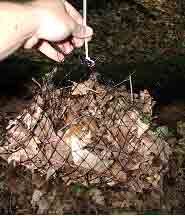The methodology for surveying and monitoring Ohio’s stream-dwelling salamanders utilizes mesh leaf bags for capturing larval and adult salamanders. The use of mesh leaf bags for surveying salamanders was first reported by Pauley and Little (1995) and has since been used by the US Geological Survey for surveys within Shenandoah National Park (Jung et al. 2000).
Constructing the Mesh Leaf Bags
The mesh bags are made from 50cm X 50cm square pieces of black large mesh (2.2cm, 7/8”) Multi-Use Netting (Easy Gardener, Inc., Waco, TX). This plastic netting can be purchased at most hardware or garden stores and is often referred to as “deer guard.” The brand of mesh netting is not important, so long as the mesh openings measure 2.2cm. To construct the mesh leaf bags, cut 12 pieces of mesh into 50cm X 50cm squares (20” X 20”). Carry these mesh squares along with 24 plastic cable ties, a measuring tape or wheel, a roll of surveyor’s flagging tape, and a permanent marker to your monitoring site.
To construct the mesh leaf bag, place approximately 0.2kg (~0.5lbs.) of leaf litter, moss, and small rocks from the area surrounding the site into the center of the net square. Then, pull all four corners of the square together and cinch them using a cable tie, thus creating a bag (Fig. 3). The bag should be loosely filled, not packed, with material. Finally, tie a piece of flagging tape through the top of the bag so that they are more visible in the stream. Bags should be numbered sequentially from 1 – 12 by writing a number on the flagging tape.

Figure 3. A mesh leaf bag.
Place the bag on the left or right side of the edge of the stream so that the bottom of the bag is completely within the water. Remove any rocks from the bottom of the stream that may keep the bag from being flush with the stream bottom. Find one or two large rocks to place on top of the mesh bag to anchor it in the water. It is also recommended that you place a few rocks just in front of the bag on the upstream side to help deflect strong water flows that may wash the bag downstream. Follow the instructions on the data sheet for recording the habitat type that the mesh bag is placed in.
When you have finished with the first bag, measure 5 meters from your starting point and construct and place your second bag on the opposite side (left or right) of the first bag. If there is no water 5m from the first bag, place the bag in the closest location containing water. Record the habitat type on the data sheet as instructed. Continue this until you have placed all 12 bags equidistant from each other along the 60-meter stream segment. Be sure to number all of the bags and to alternate between the right and left side of the stream.
Next section: Sampling
